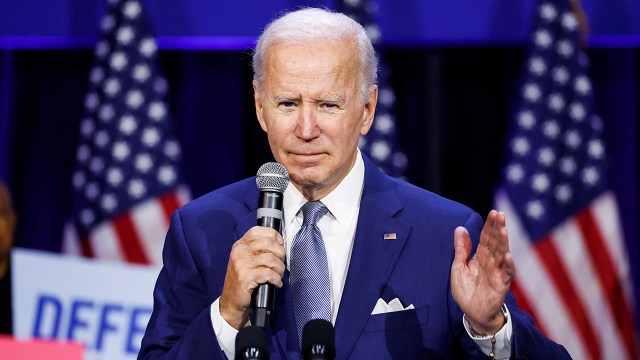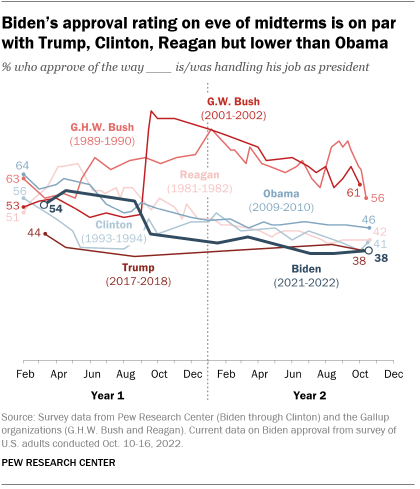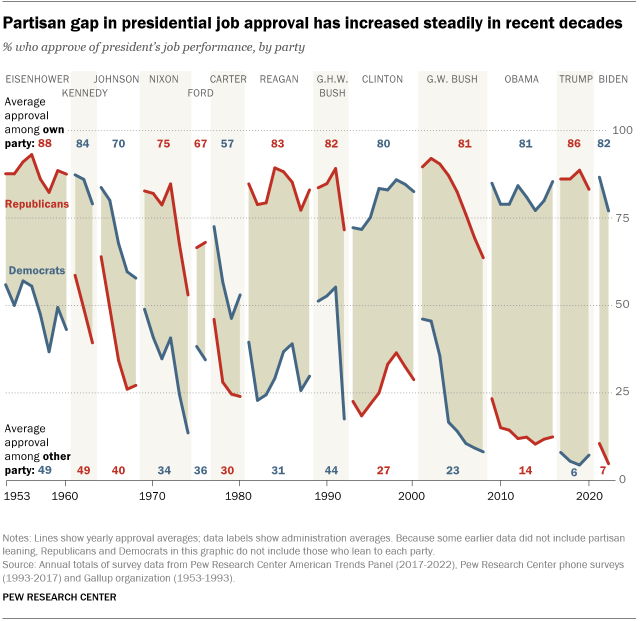
Nearly two years into his presidency, Joe Biden’s job rating stands at 38% – identical to Donald Trump’s approval rating at a similar point in his presidency, but lower than those of some other recent presidents in the run-up to their first midterm election.

The trajectory of presidential job approval differs for each White House occupant. Biden began his presidency with majority approval: In March 2021, 54% of Americans approved of Biden’s job performance, and his rating rose to 59% a month later. But his popularity declined sharply last summer and has been in the low 40s or high 30s since then.
By contrast, Trump’s job rating remained remarkably stable during his first two years in office – and well after that. In fact, until his job approval fell dramatically following the Jan. 6 riot at the U.S. Capitol, roughly four-in-ten Americans consistently approved of Trump’s job performance. In October 2018, close to two years after Trump was elected, 38% approved of how he was handling his job as president.
We conducted this analysis to understand Joe Biden’s job approval ratings in a historical context. For this analysis, we looked at yearly averages for presidential job approval based on annual totals of Pew Research Center surveys from 1993 to 2022 and Gallup organization data from 1953 to 1993. Pew Research Center surveys on Biden’s job approval have been conducted on the Center’s nationally representative Americans Trends Panel (read more about the ATP’s methodology); surveys conducted between 1993 and 2017 (and earlier Gallup surveys) were conducted by telephone.
Biden’s job rating is fairly comparable to Ronald Reagan’s (42%) and Bill Clinton’s (41%) at this stage of their presidencies, but lower than Barack Obama’s (46%). Those three presidents – like Biden – lost ground over their first two years in office.
Biden’s current rating is much lower than those of George W. Bush (61%) and his father, George H.W. Bush (56%), on the eve of the midterms in the second year of their presidencies. Positive views for both Bushes increased sharply during their early months in office – after the Sept. 11, 2001, terrorist attacks in the case of George W. Bush and after the U.S. invasion of Panama and the Persian Gulf War in the case of George H.W. Bush – but subsequently declined.
The decrease in Biden’s approval ratings since his first months in office has been primarily driven by a decline among Democrats and Democratic-leaning independents. Today, 71% of Democrats approve of the way Biden is handling his job as president, down from 93% in April 2021. There has been a more modest decline among Republicans and Republican leaners, who largely opposed Biden from his early days in office. Currently, just 6% of Republicans rate Biden’s job performance positively, down from 18% in April 2021.
Partisan divides in views of the president have grown in recent years
Presidential approval ratings have always been partisan, with members of the president’s party offering more positive assessments than those in the opposing party. But the differences between Republicans and Democrats on views of the president have grown substantially in recent decades, primarily driven by more negative ratings among members of the party opposite the president.

Over the two years of his tenure to date, an average of 82% of Democrats have approved of how Biden has handled his job as president, compared with just 7% of Republicans – a 75 percentage point gap.
Although views of Biden’s job performance are roughly the inverse of Trump’s over his four years in office – an average of 86% of Republicans and 6% of Democrats approved of Trump’s handling of his job as president – the partisan gaps for both Biden and Trump are wider than those of previous presidents.
More than six decades ago, President Dwight Eisenhower enjoyed an average 88% approval rating among Republicans and a 49% approval rating among Democrats – a 39-point partisan gap. Even some more recent presidents, such as George W. Bush (with an average approval rating from 81% of Republicans and 23% of Democrats, or a 58-point gap) and Obama (81% of Democrats vs. 14% of Republicans, a 67-point gap) had higher approval ratings from members of the opposing party.
